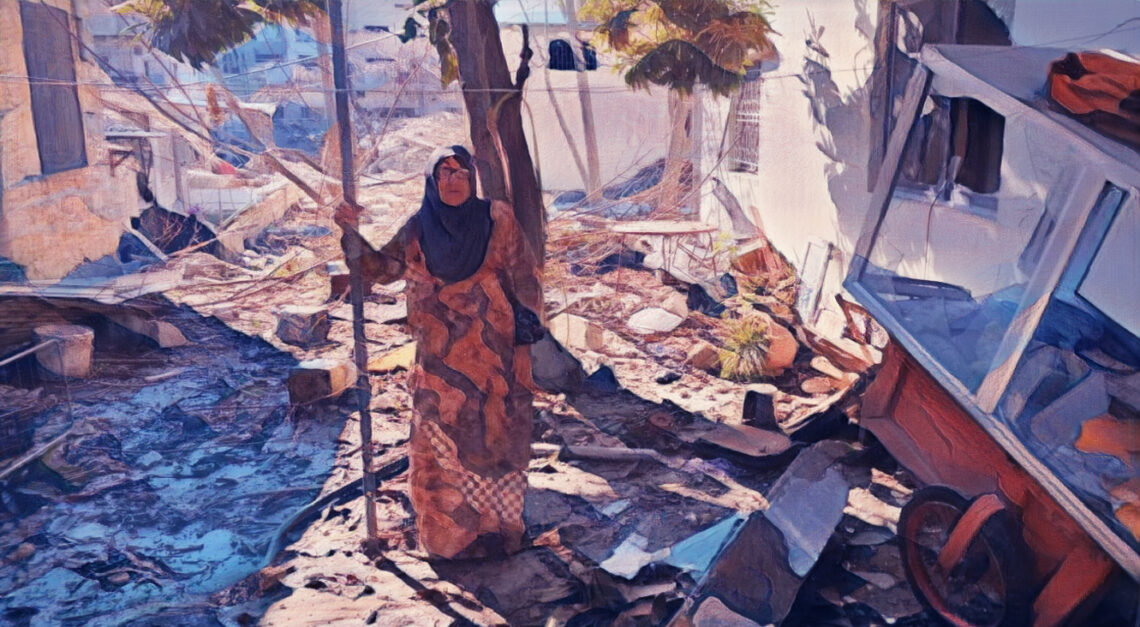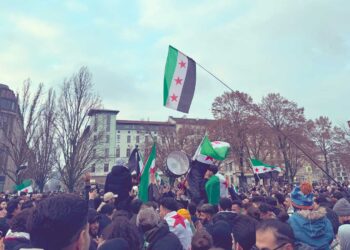“[…] Is ‘temporary peace’ the only form of permanence in South Lebanon?” — Shop owner, Rmeich, December 2, 2024.
On November 27, 2024, at 4 AM, a ceasefire agreement between Hezbollah and Israel took effect, bringing an abrupt but precarious halt to months of violent conflict. By dawn, the roads leading south were already filled with cars, as displaced residents—belongings hastily packed—made their way back to homes they knew might no longer exist. Returns surged within hours, and a reported 88 percent of those displaced had returned to their towns and villages within 48 hours, reflecting the collective urgency to reconnect with their land and communities.
Yet, for the people of South Lebanon, the ceasefire is no panacea. It is, at best, a fleeting pause in a protracted cycle of violence that has repeatedly displaced them. Caught between relief and disbelief, they are rebuilding without guarantees, navigating the fragile space between survival and the enduring dream of peace.

A language of belonging and ceasefire “in name only”
Belonging in South Lebanon transcends physical geography. It is a deep, unyielding connection to the land—rooted in ancient olive trees and soil cultivated through generations. Yet this language of belonging has been consistently met with violence, erasure, and forced displacement. As part of a larger study we are carrying out at the Institute for Migration Studies at the Lebanese American University, we interview those making the venture of return. A farmer from Aita al-Shaab tells us: “The occupier will never understand the language of true belonging. It is written in the trees, the soil, and the stones of our land. We are part of this place, even if they destroy everything around us.”
Since October 2023, the South has endured one of its darkest chapters. Entire villages—Aita al-Shaab, Khiam, Odaisseh, and dozens of others—have been systematically destroyed in a campaign that decimated over 40,000 homes and uprooted tens of thousands of lives. For those now returning, rebuilding is not a choice; it is a compulsion. Their connection to the land drives them to reconstruct homes and livelihoods without assurances of stability or security. An Elder from Khiam shares: “Every ceasefire is like building a house on sand. We have no foundation, but we rebuild because it’s the only thing we know how to do. You know, this is who we are. If the ceasefire is for 60 days or 60 years, we will rebuild either way.”

While the ceasefire brought a pause to active conflict, violations by the Israeli army have continued. According to Anadolu Agency, Israeli forces breached the agreement 74 times within its first week, employing artillery, airstrikes, and intimidation against civilians. In Naqoura, Israeli forces fired on homes and warned residents not to return, further deepening the climate of fear and uncertainty. A resident from Naqoura shares: “[…] they call it a ceasefire, but it doesn’t feel like one. The sound of gunfire doesn’t stop, and neither does the fear. But we are exhausted from being displaced. We don’t have anywhere else to go. We are done living in shelters. We will wait for what we hope is the final stretch of the conflict to end—this conflict at least. We have endured far worse.”
Hezbollah has since carried out what they deem “a defensive warning strike” against Israel following its ceasefire breaches, as both sides continue to test the fragile ceasefire’s hold. International actors, including ceasefire brokers, U.S. and France, have issued warnings about the potential collapse of the ceasefire, yet their ability—or willingness—to enforce accountability remains in question. For those on the ground, the daily violations reinforce skepticism about the durability of any agreement as Israel continues to threaten to expand the war.
On relief and disbelief
Against this backdrop, the return home has brought a fragile sense of relief for many, but it is tempered by disbelief. Decades of temporary “peace agreements” and repeated cycles of displacement have eroded trust in any lasting resolution. For many residents, “temporary” has become a state of normalcy. A displaced resident of Maroun al-Ras shares: “We don’t believe in permanence here. Temporary has always been our normal. Relief is not real; it’s just a feeling we hold onto because we have no other choice. What ceasefire? Look around. If they are not bombing Beirut, does that mean they are not bombing Lebanon? Is South Lebanon not Lebanon? Regardless, we are returning in masses. We will navigate this. They will give up eventually, all parties to the war. Historically, one of them always has.”

The act of rebuilding, however, remains deeply symbolic. In the face of destruction, it serves as a defiant assertion of belonging and resilience, even when assurances of safety are absent. A teacher from Rashaya al-Fukhar tells us: “[…] the Americans say this ceasefire will last. Do we believe them? We try, but their promises have failed us before. We do see that there is some de-escalation, and this is all we need to return honestly. You know us. We will not let our homes go. We never have and never will. I just wish our own government would stop ‘celebrating’ a ceasefire, and actually reassure us that we are part of the country, and part of their concern.”
Beyond the illusion of peace
For the people of South Lebanon, the ceasefire offers neither closure nor justice. It cannot restore livelihoods, heal the poisoned soil, or address the structural violence that persists long after the bombing stops. A shopkeeper in Nabatieh who says he “has lost everything” shares: “[…] this is not peace. Peace is justice, hope, and belonging. A ceasefire is just a pause in the violence, not an end to it. We know this too well. We were in a ‘ceasefire’ for close to 20 years. We are always fragile. This patchwork political solution is always fragile. Nonetheless, we are returning. This is all we know. If they give me another 20 years of no bombs, then I accept. Peace is a big word.”

The international community often conflates ceasefire agreements with peace, overlooking the ongoing plight of those living under its shadow. This narrative perpetuates a form of erasure that dismisses the humanity and history of the displaced. For South Lebanon, this has long-been true. Peace, as the people of South Lebanon articulate, is not merely the absence of conflict but the restoration of justice, dignity, and the right to belong.
A resident of Rmeich tells us: “[…] while we hold on to the prospect of a real ceasefire, and maybe, just maybe a conversation on peace, we will be here. We will remain in our homes. And we will help our friends and neighbours rebuild theirs at the borders of our town. But you tell me: what does peace look like? Another 20-year ‘ceasefire’ with a couple of sporadic scares?”
What now?
While many in Beirut and other parts of the country celebrate the ceasefire, it is clear that such relief disregards the reality in South Lebanon, where the truce has not held despite an initial wave of hope.
In reality, the conflict has merely reverted to its pre-September 2024 state, concentrated in the South, leaving its residents to endure yet another chapter of neglect and violence. This stark divide underscores the historical political marginalization and neglect of the South, where solidarity from other regions remains fragile at best. For those in Beirut and other major cities, the conflict now once again feels “distant,” allowing them to view the ceasefire as a success. But how can we speak of peace when the South is still being bombed?
As the holiday season approaches, the South faces a different reality, one shaped by continued insecurity and the absence of meaningful support from the central government. This protracted neglect—decades in the making—means that for the people of the South, this ceasefire is merely another pause in an unending fight for recognition and dignity. A resident of Aita al-Shaab shares: “[…] we are pleased to see the army. We are pleased to be slightly more seen. But what is the central government’s plan for us? Is anyone going to tell us? Are they going to tell us what the strategy is? Will there ever be one for those of us forgotten in the country’s borderlands?”

Yet, the resilience of South Lebanon’s people remains unshaken. An elder from Aitaroun states: “We are tired of rebuilding, but we will never stop. This land is ours. They can destroy our homes, but they cannot destroy our connection to it. They have tried. They will likely continue to try. But we remain hopeful that this time is different.”
Hope alone, however, cannot mend land scarred by unresolved conflict or lives fractured by violence. Rebuilding must be accompanied by accountability for those who perpetuate this destruction. Narratives that dismiss displacement as collateral damage must be challenged, and the voices of South Lebanon’s residents must be centered in efforts to create a peace that is both just and enduring. Until then, the people of South Lebanon will persist in their fight—not just for survival, but for a future where their belonging is acknowledged, their struggles are not ignored, and their lives are no longer lived under siege. The question is not whether they will rebuild—they always do. The question is whether the world will finally listen.








